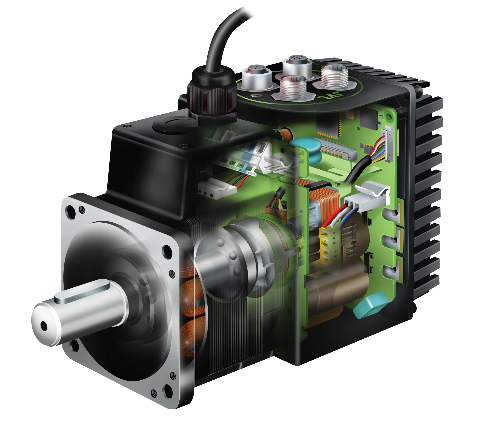Stepper motors follow a laundry list of x/y axis coordinates provided by the controller. The torch proceeds to each point in the file, perhaps a half a thousandth of an inch apart, both axes working in precise synchronization with each other. The relatively simple circuitry involved provides great reliability, good low speed torque, and easy set-up. Positioning errors don't occur, since stepper motors know in advance where they are going and when to stop.
Servo motors depend upon "closed-loop" circuitry to supply information back to the computer so that positioning errors can be continuously corrected. This feedback is provided by encoders, which in some respects, are like the bicycle wheels that some road builders and others use to measure distances.
A new type of servo motor called an "intelligent servo motor" has recently appeared on the scene. It is useful for some applications, and we use it in our automatic torch height controls. In fact, we probably purchase more of them than any of our competitors. The motor has some programmable computer circuitry incorporated into it, which lets it independently follow simple instructions. It works well with our torch height controls, due to their low torque demand. We believe intelligent motors are impractical for driving a cnc machine, for reasons given below.
The following paragraphs explain each of these types of motors in more detail.
Stepper Motors
Stepper motors are relatively inexpensive, and provide the same or greater accuracy as servo motors. Sufficiently powerful stepper motors for a given application do not lose steps. Stepper motors are no more likely to lose steps than a servo encoder is to pass bad information back to the controller. This hoax is pure hype generated by manufacturers who are either unfamiliar with stepper motors, or who are distorting facts to market their particular product. If for some reason a stepper motor does encounter an obstacle it can't overcome, such as a tipped up plate, it will simply skip steps, hurting nothing. If a servo motor encounters the same obstacle, it will sit there and fight itself until it breaks a gear tooth or burns up.
If a stepper motor goes bad, which can happen to all three types of motors, replacement cost is under $200.00. No elaborate tuning process is needed to keep it functioning accurately. Best of all, its excellent low rpm torque lends itself perfectly to cnc plasma and oxy-fuel shape cutting, without the need for backlash producing gearboxes. The low speed torque makes it possible to use a timing belt and pulley reduction, with virtually no backlash.
Bear in mind that the vast majority of cnc cutting movements with stepper motors are at less than 300 rpm motor speed, which translates to about 130 inches per minute on Torchmate machines. Cutting speeds and rapid traverse moves up to about 350 inches per minute are possible, although cutting would rarely require speeds in excess of 150 inches per minute. Rapid traverse moves faster than 350 inches per minute are virtually never needed, as the distance between pieces being cut rarely provides sufficient time for ramping (acceleration and deceleration). Don't be taken in by claims of super fast speeds. The more important issue in cnc plasma and oxy-fuel applications is how slow a move a machine can make. Oxy-fuel cutting of thick steel can require speeds as slow as 2 or 3 inches per minute.
The use of dual X axis motors is easier and more precise with stepper motors than with intelligent motors, which require instructions to be passed along from motor to motor in kind of a daisy chain, rather than directly to both motors from the controller. With steppers, the two motor drivers receive identical simultaneous instructions from the computer, one in reverse of the other, reducing the chance of mis-communication.
Servo Motors
Servo motors are somewhat more expensive than steppers -- perhaps double the price, or more. They are generally just as accurate, if maintained in a proper state of tune, however they rely on encoders to provide positioning information back to the computer. Thus the complexity of the system is at least doubled, with no accuracy advantage, greater initial cost, and more maintenance issues. The "closed loop" rhetoric that some manufacturers play up sounds convincing to the uninitiated, but provides no benefit over a simpler and more reliable stepper system.
Servo motors are available in larger sizes than stepper motors, and powerful servos are generally used on heavy machines with gantry carriages in the 500 to 1,000 lb range. They offer no advantage whatsoever on lighter machines, such as Torchmate and its competitors.


Love to read it,Waiting For More new Update and I Already Read your Recent Post its Great Thanks. CNC machine
ReplyDelete